Content
- Classification of the state of hypnosis
- Classical
- Pharmacological (psychotropic)
- Hidden
- Pathological
- Ericksonian
- Generative trance
- Self hypnosis
- Gypsy
- Regressive
- Contraindications
- Potential harm
- Loss of rapport
- Hypnosophilia
- Hypnophobia
- The consequences of regressive hypnosis
- Do I need to prepare for a hypnosis session
- Techniques step by step
- Classical
- Fixation of attention
- Technique 5-4-3-2-1
- Hypnotizing with a glance
- Counting up to 10
- Counting up to 100
- Hidden
- Nominalization
- Dissociation of consciousness and subconsciousness
- Breaking the template
- Pulling into a new reality
- Overload
- Methods of protection against hidden hypnosis
- Self hypnosis
- Gypsy
- Hypnosis videos
Hypnosis has been known to man since ancient times, its name changed depending on the era and the civilization that resorted to it. Contrary to popular belief and similar characteristics, hypnosis is not sleep and differs from meditation and trance. It can be described as putting a person into a special state of consciousness, in which the hypnotist can give him instructions on a subconscious level, provide a therapeutic or control effect.
Due to the abundance of goals and methods of hypnosis, it can be available to anyone, some of its elements are found on television, in advertising, politics and other areas of everyday life. This skill is used not only by professionals and experts in psychological sciences, if you have knowledge and experience, you can hypnotize on the street, in public transport or at home.
Classification of the state of hypnosis
Throughout the day, a person periodically stays in a state of unconscious light trance, dreaming, experiencing or reflecting on things that are not related to his current business. This detachment is characterized by a decrease in attention and comprehension of what is happening against the background of an increase in inertia and a predisposition to outside influence.
The opposite of this state is awareness, which consists in developing constant concentration on any aspect of the performed action with an acceptable switch of attention. Hypnotic influence can be called controlled trance.
Hypnosis is carried out by focusing or distracting a person's attention in order to increase his suggestibility. The techniques used for this are designed to block critical assessment of the commands or attitudes received and put consciousness into a state between sleep and wakefulness (somnambulism), as a result of which the hypnologist can work with subconscious.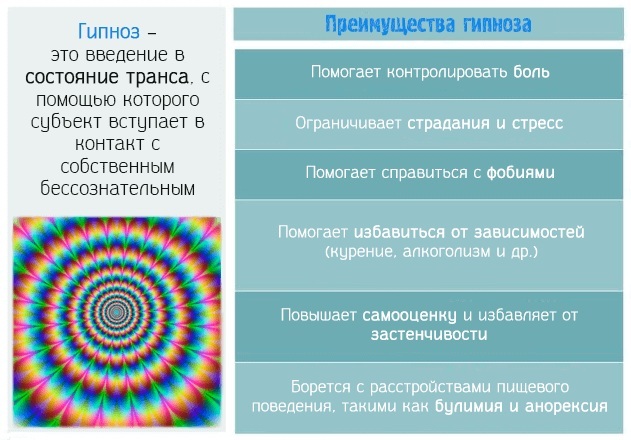
In traditional hypnosis, this is achieved by causing inhibition in most of the cerebral cortex while maintaining excitement in that area that is tuned in to contact with the hypnotist. In a hypnotic context, this site is called a watchpoint or rapport zone, which is verbally influenced.
In addition to the level of the hypnologist's skill, in a classical hypnosis session, the visitor's exposure to it, called hypnotizability, matters. A person cannot be brought into an appropriate state against his will, and the hypnotized person does not lose memory, can resist or lie.
The indicators of a person's physical strength under hypnosis are identical to those in the normal state, and the state of increased susceptibility and suggestibility will not help to force the hypnotized to be unusual or unacceptable for him actions.
| Type of hypnotizability | Peculiarities |
| Natural | Personal propensity to enter a state of hypnosis of one or another level of immersion. The thinking of any person can change from logical-rational to sensory-reflex, but not everyone can do this on purpose. Usually those capable of this are developed in the emotional-volitional area and have a rich imagination. This is inherent in creative people who know how to abstract, scouts, athletes and those employed in extreme professions. The ability of voluntary dissociation and a clear strategic assessment of a situation requiring attention while maintaining the performance of physical actions is characteristic of the “Whole Nature” archetype. |
| Phobic | Phobic suggestibility is more pronounced. It manifests itself randomly and uncontrollably when exposed to traumatic factors of irritation. Unhealthy suggestibility is divided into 3 types:
|

In addition to psychological intervention, hypnosis is also used in conventional medicine. Back in the 19th century, operations were performed with its help, making patients immune to pain impulses. Simple manipulations in the service sector help to generate customer interest in certain products or services.
Hypnosis and its elements can be used both in criminal and law enforcement environments, as well as in social engineering mechanisms. The depth of hypnotic immersion depends on which of the ways the person is hypnotized. They differ in methods and effect. Some of the common types of hypnosis are described below.
Classical
To enter into a hypnotic state, it is necessary to capture the attention of a person. The Portuguese monk Faria discovered in the early 19th century that somnambulism could be induced by fascination, meaning verbal or non-verbal techniques to increase the susceptibility of the hypnotized to information.
The researcher's gaze and the focusing of his test subjects' visual attention on objects laid the foundation for the classic trance session. These methods are used to this day, they also served as the basis for stage hypnosis.
The mesmerizing effect of fascination is now also achieved through monotonous or specially intonated speech, background music, focusing on an emotionally responsive image, a swinging pendulum, or similar instruments hypnotization.
This stimulation awakens feelings and promotes the release of hormones responsible for joy or anxiety, which reduce the ability to think logically and interfere with critical analysis of the situation.
You can hypnotize a person at home with the help of traditional directive hypnosis, which implies a direct effect. In it, the hypnotized person is comfortable sitting or reclining. He looks at objects to fix the attention, hypnotizing a person, or listens to his attitudes with his eyes closed. In the case of speech exposure, the hypnologist must have a well-trained voice and speak clearly enough.
Directive hypnosis is usually used in the treatment of diseases and disorders of a psychological, neurological and psychosomatic nature, as well as in stage performances. During the session, inhibition occurs in both hemispheres of the patient.
Pros of the classic version:
- the speed of achieving somnambulism and receiving suggestions;
- feeling of "miracle".
Cons of the directive method:
- according to statistics, only one of the three is hypnotized in this way;
- the attitudes received come from the hypnotist, as a result of which the patient often receives suggestions based on other people's impressions.
Pharmacological (psychotropic)
Before the session, a person takes special psychotropic drugs that sharpen his feelings, perception and control. Hypnosis according to this approach is performed under the watchful supervision of a physician and is most often used in the treatment of various addictions. The session ends with the instruction to forget about its details and the suggestions received.
Hidden
Dangerous for uninformed people. The principle of action is to draw the attention of the object of suggestion to something and establish an emotional connection with it. through empathy, expression of interest, active discussion of the topic of interest and similar techniques, followed by suggestion. It is used in the social sphere, for criminal purposes and in the work of law enforcement agencies.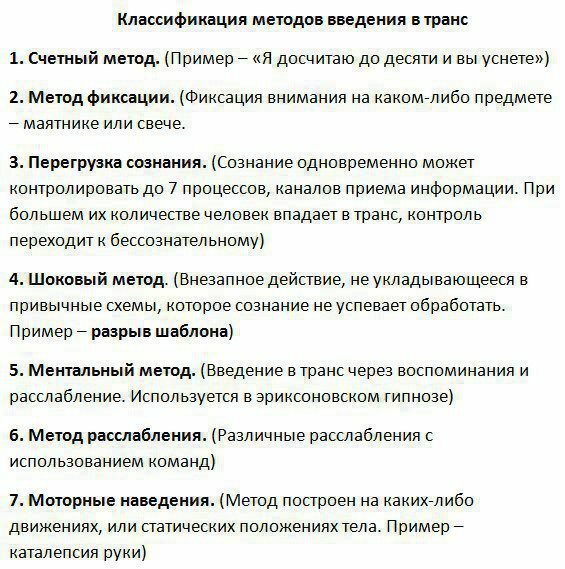
Some of the common techniques for covert hypnosis are:
| Technique | Peculiarities |
| Nominalization | Filling oral speech with abstractions formed from verbs to immerse the interlocutor in a light trance. |
| Dissociation of consciousness and subconsciousness | A veiled division of a person's personality into a conscious and subconscious subpersonality in order to establish a trusting connection with the latter. |
| Breaking the template | Failure to perform any routine or automated action to cause confusion. |
| Pulling into a new reality | Creating the desired inner state of the interlocutor by immersing him in an image, instilling certain feelings in him and discussing future success. |
| Overload | Reducing the brain activity of a person by exceeding the combined information available to him for processing or by overloading his channels of perception. |
Pathological
It is a consequence of somatic, mental and psychosomatic ailments and can occur spontaneously. For example, people with schizophrenia have an unstable response and susceptibility to suggestion. These indicators also change with epileptic or hysterical seizures. In such cases, hypnosis is contraindicated, as it poses a threat to health.
Ericksonian
The famous psychotherapist and master of medical hypnosis, Dr. Milton Erickson, in the 20th century, developed a way to enter somnambulism at the request of the hypnotized. The Milton Model served as the prototype for many of the current hypnotic immersion techniques.
This method of introducing into a trance does not cause inhibition in the right hemisphere of the brain, it occurs only in the left hemisphere, which turns off the critical assessment of consciousness. The specialist, on the other hand, interacts with the wise unconscious of the visitor, establishing a connection with his reality.
In this case, feelings are involved, and also techniques of hidden suggestion, storytelling in narration, non-verbal communication and similar methods of influence are used. In contrast to the directive approach, the Ericksonian method from the outside looks like a normal conversation.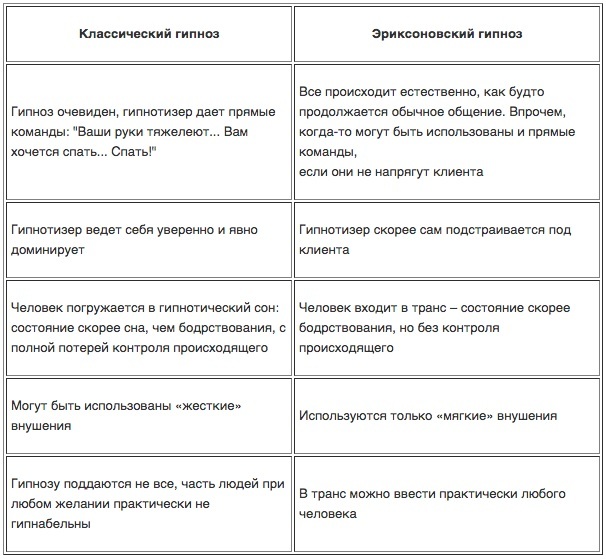
Pros of Ericksonian hypnosis:
- available to every person;
- an imperceptible and smooth entrance into a state of somnambulism;
- the patient's subconscious can itself find answers to questions of interest;
- suggestions are based on individual impressions and images of a person.
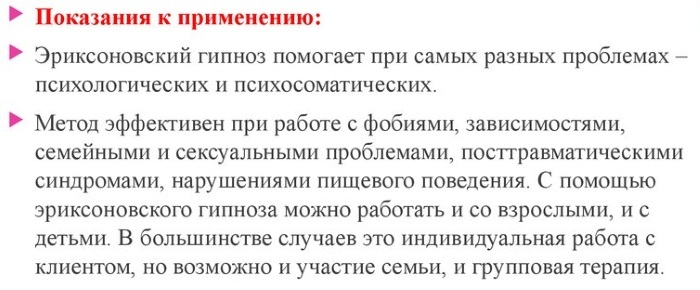
Cons of the Erickson method:
- for this version of hypnosis to work and to solve his problems, a person himself must desire this;
- a session on this approach lasts longer than traditional technology.
Generative trance
Generative approach based on the Milton model is a deeper technology interactions - work with questions of interest and search for answers to them both in the subconscious and in environment.
A feature of the generative method is the activity of both hemispheres and interaction with various opposites, for example:
- somatic / cognitive;
- resources / problems;
- future / past;
- external / internal.
The specialist in this case simply serves as an accompaniment for his visitor, who processes and transforms his problems at a deep and creative level of consciousness, getting the required resources.
Pros of Generative Trance:
- the transience and benefits of the session;
- lack of risks;
- versatile approach.
Cons of technology:
- the effectiveness of the session is due to the presence of his desire among the visitor;
- the method requires professional training.
Self hypnosis
The work of a person with his own subconscious without the participation of a specialist.
To introduce oneself into the appropriate state of consciousness, many methods are used, including:
- pronouncing affirmations;
- focusing on the subject, breath, image, music and similar focuses of attention;
- listening to recorded suggestions.
Among hypnologists, there is disagreement about the attribution of self-hypnosis to hypnosis, since with it there is no hypnotic influence in its traditional sense. Self-hypnosis is used to improve cognition, gain self-control, and reduce pain sensitivity. It is also used in the therapy and treatment of asthma, migraine, anxiety, depression, skin diseases, insomnia and obesity.
Gypsy
According to scientific data, the average person can perceive no more than 5-9 streams of information at the same time. The gypsy method of hypnosis is to surround the victim and overload their perception through multiple touches, simultaneous conversations, visual distraction and installation on amnesia at the end.  This is commonly used in a street robbery.
This is commonly used in a street robbery.
Regressive
Regressive hypnosis, which is especially popular among parapsychologists and esotericists, allows you to find out about your previous incarnations and is used as a psychological aid. The task of the specialist is to enter the visitor into a state of regressive trance in order to extract the necessary information from his subconscious by means of specially composed questions.
A person restores episodes from a series of his past lives, according to the opinion of official science, which are forgotten by him events from his real life. Based on the information received from the patient's "Higher Self", it is possible to determine the causes of certain disorders or mental deviations. This data also helps the visitor of the session to realize the mistakes he made in the past, which contributes to positive motivation and improvement of the person's condition by activating his hidden resources.
Contraindications
The main reason to abandon hypnosis is mental abnormalities, except for cases when the session is intended for their treatment or therapy. In this situation, hypnosis should be performed by a professional with the appropriate medical specialty or under the supervision of a specialist.
Other grounds for refusal are:
- healing sprains, fractures and wounds that impede or impede normal movements;
- paranoid delusions resulting from damage to the cerebral cortex;
- asthma;
- alcoholic or drug intoxication;
- convulsive and epileptic seizures;
- the effects of sedatives, antidepressants, tranquilizers and antipsychotics;
- cardiovascular insufficiency;
- affective insanity;
- retarded development of the psyche and mental disorders.
Viral infections, nausea, fever, malaise, or diarrhea may be reasons to postpone an appointment with a hypnotist. Hypnosis is undesirable during pregnancy as it can cause negative emotions and thus affect the health of the fetus. The most vulnerable period is the 1st trimester. For pregnant women, exceptions are made in cases where the benefits significantly exceed the possible risk, for example, with a fear of childbirth.
Hypnotherapy has safe techniques for young people, performed by professionals when indicated for hypnosis. Although the brain develops at an individual rate, it is not recommended to hypnosis children under the age of 9. Child hypnosis is also not performed in the event of the death of a family member, friend or pet, change of social circle or place of residence, as well as in case of divorce.
Potential harm
It is possible to hypnotize a person at home both with benefit for him and with undesirable consequences. All types of hypnosis, used for therapeutic or manipulative purposes, one way or another affect the subconscious, which can damage the psyche. The qualifications of the hypnotist are of great importance; the following are the most common complications of classical hypnosis.
Loss of rapport
The session may not have an effect if the quality of contact with the visitor is poor, who, without leaving the immersion, can stop receiving suggestions and react to the hypnologist. This usually happens due to the specialist's short-term distraction from the session.
Hypnosophilia
This phenomenon is most affected by adolescents, women and children. After the session, they begin to feel strong sympathy for the hypnotist, perceiving the process as a miracle, which can also push them to stop following the specialist's related advice.  Patients can increase the strength load, stop taking medication, and take other rash actions.
Patients can increase the strength load, stop taking medication, and take other rash actions.
Hypnophobia
Some people may experience a dread of hypnosis before or during the session itself, which will interfere with sufficient immersion. This, accordingly, will reduce the effect of exposure or lead to the opposite result. Insomnia can be another consequence of being frightened during a session.
The consequences of regressive hypnosis
Despite the fact that this type of therapy has received many positive reviews, adherents of traditional medicine warn against regressive immersion due to the likelihood of developing mental disorders in people predisposed to them and having an unstable psyche.
In some cases, regression has entailed significant psychological damage, and some countries have imposed an official ban on it. Before signing up for regressive hypnosis, it is recommended to balance the risks with the benefits.
Do I need to prepare for a hypnosis session
It is possible to hypnotize a person at home without any special preparations, the main condition for this is a fresh state of mind and body. For the best effect of the session, it is recommended to get enough sleep, avoid heavy mental or physical stress, excitement, and try to tune in to the upcoming visit to the hypnotist.
Immersion in somnambulism is performed in a sober state, therefore, it is necessary to exclude the use of any psychotropic drugs, including drugs for good sleep and drugs that calm the nervous system.
Techniques step by step
Most types of hypnosis can be attributed to one of two conditional classifications, differing in the method of invoking the corresponding state:
- Smooth immersion in somnambulism, characterized by the monotony of the flow of information, which causes the effect of fascination through certain channels of perception.
For example, the touch is influenced by running the hand along the patient's body at a distance of several centimeters from him.
To influence the ear, they use the voice of a hypnologist giving verbal settings, as well as the ticking of a clock, noises of nature, a waterfall, background music and similar relaxing sounds.
When the hypnotized person is introduced into a trance by a visual method, he is asked to fix his gaze on the blinking of light, the movement of the clock hands, a swinging pendulum or a special image. Some professionals induce somnambulism in their visitors by staring intently into their eyes. The hypnotic gaze can be developed with specific exercises.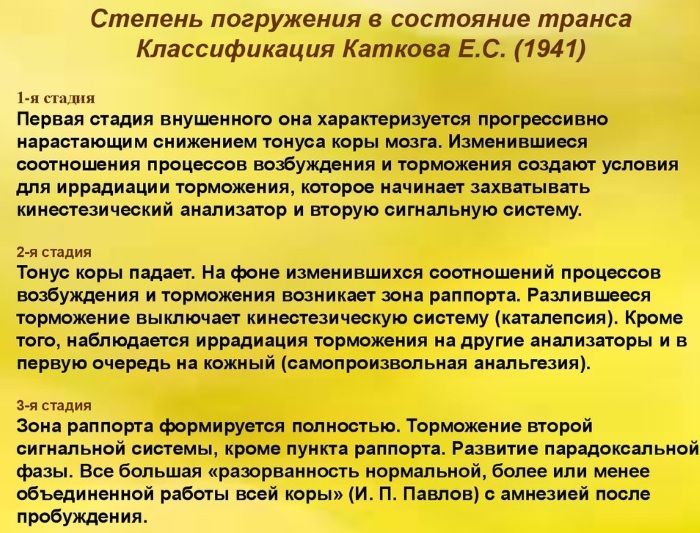
- The shock effect when suggestibility is increased by sudden draws of attention. This is most often done in ways such as a harsh order or sound. The use of a weak electric current is also part of this method.
Various methods of hypnosis also differ in the depth of immersion in somnambulism. Traditionally, it is divided into 3 levels.
- Light fascination, in which the mind of the hypnotized remains active. The session visitor can understand and listen to the hypnotist.
- The average level of hypnotic immersion, characterized by a decrease in mental activity due to inhibition in the cerebral cortex. This state allows a person to perceive only sufficiently logical and understandable suggestions.
- A deep level of somnambulism, suspending a person's control over his own consciousness. A completely relaxed patient is open to suggestions other than those that conflict with his beliefs.
Among the techniques discussed below, pathological, pharmacological, regressive, Erickson and generative diving are not described. Somnambulism in the first case is a consequence of psychosomatic and neurological diseases, and in the second it is caused artificially for medicinal purposes.
To prevent possible risks, it is recommended to conduct a session of regressive hypnosis with a specialist. Ericksonian and generative trance techniques require specialized knowledge and skills. Self-hypnosis is considered in part, as it has many different variations, differing in the goals and methods of diving.
Classical
Usually directive diving is performed according to the following scheme:
- Awaken the trust of the visitor.
- Draw a line between his consciousness and subconsciousness, introducing a person into a state of relaxed detachment.
- Give the necessary settings. With light hypnosis, suggestions are laid in the form of metaphors, and with deep immersion, direct instructions can be given.
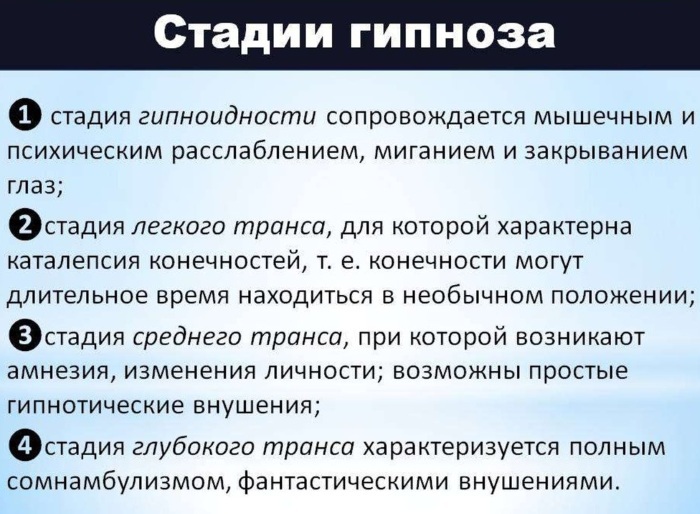
After the classic session, the person is usually returned to normal, given the installation of well-being, and informed that he will wake up when the hypnologist counts to 10. Professionals can also add phrases to address possible side effects of immersion, such as feeling sick, dizzy, and nauseous.
A wake-up call can also be a clap of your hands or another action, which is agreed with the visitor before the session. In some cases, a person may not come to his senses immediately, or, having plunged into a normal sleep, wake up later. Science is not aware of cases of hypnotic immersion without the subsequent exit from it, which occurs in any case.
It is possible to hypnotize a person at home through classical hypnosis without studying professional technology from the field of psychology, but some traditional immersion methods will require workout. The following are simple methods of directive hypnosis suitable for laymen. The hypnologist's voice should sound confident, calm, and monotonous. For the given speech recommendations, you need to carefully prepare your text or find the appropriate option on the Internet.
Fixation of attention
The simplest fixation technique is based on visual impact:
- The hypnotized person should focus on an object that is held about 25 cm away from him. Better to use luminous or glittering objects. As this focus of attention, you can use objects such as a glass ball, iron key, coin, pen.
- A feeling of security and drowsiness is caused in a person, followed by a feeling of heaviness in the limbs and a transition to a state of somnambulism. To do this, he is relaxed, calmly repeating the appropriate phrases one or several times. For example, that his body is filled with warmth, as if he is sitting in a warm bathroom.
Consciousness does not draw a clear line between imagination and real sensations. The easier it is to imagine the suggested images, the faster they can be felt, although the period of immersion in hypnosis is individual.
The patient who is concentrating on the subject should not be allowed to fall asleep. Phrases should be chosen carefully, for example, "Your mind is falling asleep," and not "You are falling asleep."
- When the person is completely relaxed, it is time to lay down targeted suggestions.
Technique 5-4-3-2-1
The beginner-friendly 5-4-3-2-1 method works through the trust generated by 5 phrases with cyclically changing numbers of statements that are easy to verify. For example, about the temperature in the room or the weather outside the window. The number of pertinent and initially unobtrusive suggestions about the inner state of the hypnotized person also alternates.
- The person should sit up straight and focus on the voice of the hypnologist, who begins the first 5 phrases with 4 logical / easily provable statements, followed by the 1st suggestion. It gives a mindset to relax the body and individual muscle groups.
- Stage 2 begins with 3 phrases confirmed by the visitor's perception, ending with 2 suggestions. They should draw a person's attention to his inner state.
- The third stage consists of 2 confirmed statements and 3 suggestions, also aimed at the internal sensations of the subject.
- In the 4th optional cycle, there is only 1 testable statement followed by 4 suggestions about the client's feelings.
- The last stage immediately begins with attitudes, alternating targeted suggestions with phrases about a person's condition as needed.

To enhance the effect, you can ask the hypnotized to close his eyes, and stimulate his imagination, reinforcing the installation by remarks that the client perceives them with his inner hearing and vision. In this method, the visitor's attention is focused instead on the object's sensations.
Hypnotizing with a glance
To immerse yourself in hypnosis with a gaze, you need training, it is developed as follows:
- An even circle is drawn on a sheet of paper with a compass. It is necessary to stop the internal dialogue and fix the gaze in the center of a circle located at a distance of one meter, without blinking or allowing any thoughts to appear. Success can be considered 5 minutes of continuous fixation of the eyes at the center of the circle.
- The same workout is done with a mirror, looking at the center of the forehead. The first step is 3 minutes, this limit should be gradually expanded.
- Another option for focusing the gaze on a point in the middle of a circle is performed with smooth movements of the head to the left, right, up, down and in a circle. Gradually, the speed of movement and the range of rotation of the head should be increased, reducing them when pain in the eye sockets appears. By training the gaze with mental silence for a duration of 5 minutes, over time, you can improve the effect by exercising for up to 15 minutes.
By itself, a hypnotic look will be ineffective, it must be combined with charm and magnetism, or with a formidable impressive look. After several months of training, you can begin your first attempts at hypnosis.
- To introduce the hypnotized into somnambulism, you need to position the person 30 cm away from you and, without blinking, look at the area of his nose just above eye level. For greater effect, it is recommended to have a chair with a higher seat - the hypnologist should look slightly downward, as if suppressing the client's will.
- The hypnotic gaze is used in combination with monotonous speech influence, introducing a person into a relaxed state. This technique also welcomes the 5-4-3-2-1 immersion method and some Erickson techniques for more. effect, you can reproduce the body position and gestures of the hypnotized, starting your phrases with the last words client. This tactic allows you to scatter the attention of the visitor, reducing the protection of his consciousness.
- Once the hypnotized person reaches the desired level of immersion, you can begin to lay suggestions in a conversational manner, for example, talking about the confidence that the person has any desires.
Counting up to 10
In the counting method, up to 10 people are placed in a comfortable position in a room with dim light.
- Having invited the hypnotized to relax and trust the hypnotist, at a distance of 8-12 cm from his face, place an open palm and ask him to stop his thoughts and look at the center of the palm. In this case, you can visualize the flow of heat from the palm.
- A close object will cause eye fatigue and a desire to close them. After 3-5 minutes, they begin to pronounce standard suggestions to induce somnambulism, starting with the phrase that after a few minutes the person will fall asleep and will only hear the voice of the hypnologist. The rest of the lines use the common hypnotic text of the count to ten, with a new immersion-promoting phrase after each count.
Counting up to 100
Immersion in hypnotic sleep through the counting technique to 100 will require the visitor to be comfortably placed in a sitting or lying position. The hypnologist then reports that he will count to 100, asking the patient to open his eyes to every odd count and close to an even one.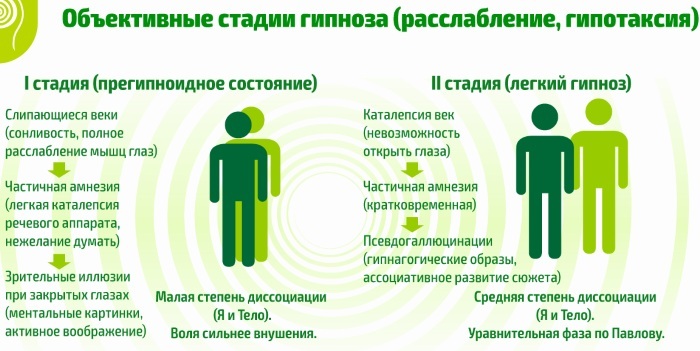
- At first, one should count quickly, but the hypnotized person must have time to open and close his eyes.
- Gradually, the count is slowed down, accompanied by suggestions about the appearance of heaviness in the centuries. Even pauses are lengthened so that the client keeps his eyes closed longer.
- When the visitor becomes noticeably more difficult to open his eyes, one should tell him that his eyelids are getting heavier and soon he will stop opening his eyes, although the count will continue. Then it must be said that the eyes have closed and will remain in this position.
- The patient is told that he cannot open his eyes, they are closed tightly, and the state of deep rest has no boundaries.
Hidden
You can hypnotize a person in this way not only at home, these techniques are used in almost any field. Used in many spheres of life and social engineering, implicit hypnosis also does not require the conditions without which classical somnambulism is impossible. His methods have varying degrees of immersion, high efficiency, and are not always used for good purposes.
Nominalization
Abstract nouns formed from verbs imply a large amount of information that makes a person withdraw into himself in search of the meaning of what he has heard.
Examples:
- realize - implementation;
- testing - testing;
- choose - choice;
- communicate - communication.
Attempts to find the relationship of 3 or more nominalizations used in speech lead the brain into a light trance. In this state, he unconditionally accepts the simple sentence uttered by the latter. The technique of nominalization is used orally, in writing it can look suspicious.
Dissociation of consciousness and subconsciousness
For this technique to work, you will need to perceive a person as 2 subpersonalities, personifying consciousness and subconsciousness. If his consciousness is critical and resilient thinking, the subconscious is open to interaction.
The vision of a person as 2 subpersonalities with a more favorable-minded unconscious should be imperceptibly instilled in him, using, for example, proverbs about the different aspirations of the mind and heart, the reasoning separating the soul and the mind, and similar veiled approval. This is a good technique for when the other person has the opposite opinion.
Another option for using this method is the simultaneous alternate discussion of 2 topics. One of them should affect the logical thinking of the partner, and the second, his feelings and inner world. Consciousness-facing discussion uses the usual tone and speed of speech, while intended for the subconscious mind of the slower conversation line uses figurative comparisons, pauses and deep chest voice.
In the course of a conversation, the number of mind-oriented phrases is gradually reduced, paying more and more attention to the topic of discussion of a person's inner sensations. In this case, the speech should be colorful, describing not only the actions, but also the attitude towards them, as well as to other elements of the discussion.
The effect can be improved by increasing the load on the interlocutor's perception channels. To do this, you can combine a discussion, for example, location, with unobtrusive touches to the interlocutor. This manner of communication ultimately activates his subconscious.
Breaking the template
A sudden disruption in the sequence of routine and unconsidered actions causes mild shock and confusion, which makes the moment suitable for suggestion. Thus, it can be made one of the programs of the unconscious person. Such events include a handshake, picking up the telephone receiver, taking a document being held out, and greeting.
Examples of violation of the sequence of actions:
- call the secretary to an ongoing business meeting and ask them to bring coffee, but only for yourself;
- hold the hand of the interlocutor when shaking hands.
This method also includes a sudden suggestion, carried out in the midst of automatically performed actions. During such processes as sneezing, laughing, yawning, coughing, crying and vivid expressions of emotions, the subconscious is responsible for a person's movements. During this time, his mind is in a state of light trance.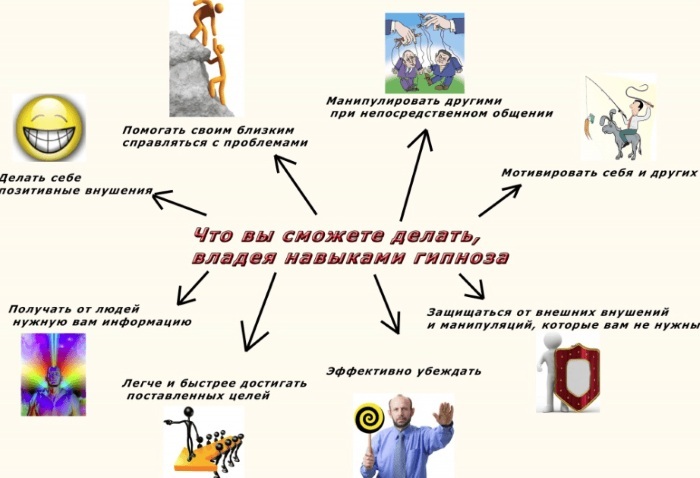
Examples of similar moments suitable for suggestions:
- reception by the interlocutor of a sitting position;
- wiping glasses;
- pulling a cigarette out of a pack;
- the moment when an art connoisseur approaches his favorite painting;
- cleaning and stuffing a tobacco pipe;
- other personality-specific gestures and reactions that cause a state of trance.
Pulling into a new reality
The methods of this imaginative technique are divided into 3 main types:
- Immersion in the image means a colorful and sensual painting of the subject of conversation or something related to the interlocutor, with a predominance of positive emotions and qualities. The listener should not only present the information received, but also have a pleasant impression from it. This way he will feel confidence in the hypnotist's seemingly more truthful speech.
- Transference of feelings is most often used to attract a partner. The principle of operation of this method is to awaken the interlocutor's memories of any feeling from his memory, followed by linking him with himself or another person in a positive context. Communication is created using marking - unobtrusive non-verbal pointing to a person in the process of visual or auditory contact. To do this, use an increase or decrease in the volume and speed of speech, short pauses before and after pointing, gestures and manipulations with objects at hand.
- To accompany in the future, it is necessary to colorfully describe the positive outcome of the action proposed or recommended to the interlocutor, creating a favorable image of the consequences of his decision. This method is suitable for any situation.
Overload
This more complex method implies an oversaturation of consciousness with information, the processing of which by a person is possible only in a limited amount. Perceptual overload leads to decreased brain activity. With the help of speech, this effect can be caused by linking your phrases with each other so that they seem to be a single and logically interconnected whole.
To do this, you can use words and phrases such as:
- so;
- while;
- and;
- due to the fact that;
- because;
- due to the fact that;
- as.
Overloading is a good persuasion technique, but it can look incoherent in writing. It is necessary to submit information with the highlighting of key points.
For example, you can create an orientation overload in space or time:
- An example of the first case is a speech built on a voluminous detailed comparison of the situation "here" and "there" with the emphasis of the voice of these two words or their meaningful locations. A veiled suggestion is also highlighted, which is laid when a trance state is detected in the interlocutor.
- As an example of the second case, we can cite an offer of an appointment that is beneficial for a hypnologist, listing the benefits of suitable days of the week. In the course of reasoning about the nuances of a particular day, you need to lay an implicit suggestion about the benefits of meeting for the interlocutor.
A relatively simple example of overloading technique is a phrase with a meaning that is not immediately clear. Meaningful tautologies are also allowed. While the mind of the interlocutor is looking for meaning, you can lay the necessary suggestion.
It should also be borne in mind that the strength of the speech impact increases with the use of more channels of perception. A proposal that does not represent any informational value can be perceived as deserving attention, if it is pronounced meaningfully, which is also used for trance and laying suggestions.
Methods of protection against hidden hypnosis
To resist manipulative suggestions, you need to be able to identify them.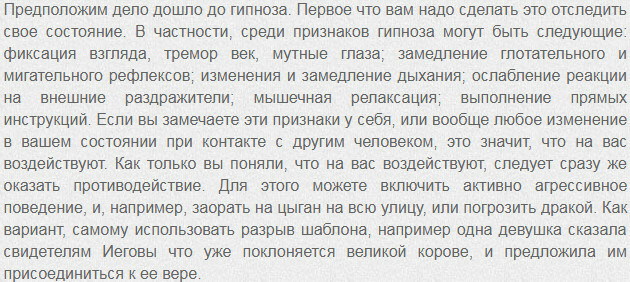
The ubiquitous hidden hypnosis can be identified by the following signs:
- High speech rate when nudging to make a choice. So, for example, magicians, when performing tricks with the audience, help the viewer to implement ideas previously introduced by them.
- Violation of the informal space of the individual. Persuasion techniques can use close-up approximation. For additional impact on perception, looks and touch are used.
- Provoking a state of stress or unforeseen excitement.
- Delay in sight of any objects or images.
- Change of purpose. In this way, unnecessary goods and services are often imposed.
- Speech impact, expressed in a change in the manner of speaking, timbre, volume and speed of the voice.
- A large amount of information sometimes does not carry the answer to the question.
- Leading questions that highlight the benefits of the other person's suggestion.
If a manipulation attempt is detected, you can use the following methods to prevent it:
- do not look into the eyes;
- act and behave atypically;
- Move, step on your foot, prick or pinch yourself to cause bodily discomfort
- leaving the manipulator is the simplest and most effective means, this is especially true when getting into a crowd of gypsies;
- be able to refuse;
- interrupt and ask in response;
- do not show phobias and fears;
- let the words of the manipulator go deafening, humming something in your mind, reading poetry or playing the multiplication table.
- do not allow personal space to be disturbed;
- prevent a quick transition from one topic to another and prevent two or more conversations at the same time;
- do not hesitate to pause, pondering the answer to the question posed;
- in conditions of cross-examination, ask him to observe his protocol, give their names to those present with him and leave those who are not specified in protocol, you can also require a conversation with only one investigator, or even refuse to answer questions without the presence of a lawyer.
Self hypnosis
The method of self-immersion, used for various types and purposes, must be performed taking care of the conditions of the process and the way out of this state.
The given recommendations are suitable for most types of self-hypnosis:
- You should enter yourself into somnambulism when you are sober, staying in good mental and physical well-being.
- It is necessary to give oneself in advance the setting for a return to a normal state, clarity of thinking and vigor of the body. This anti-sleep suggestion may include waking time.
- In self-hypnosis, countdown and direct counts are also carried out.
- They come out of hypnotic trance gradually, so you should also provide time to fully come to your senses.
Gypsy
Gypsy hypnosis, a form of the perception overload technique, exposes the mind to an abundance of information emanating from many sources at the same time. A common stereotype of robbery by gypsies is the environment of a person from all sides, each of the participants who at the same time speaks with the victim, touches her clothes, flickers in front of his eyes, energetically asks about something or offers.
When, under such influence, a question or request for money or other values is asked, the person mechanically moves his hand in this direction, thus revealing their location. He may not give the money, but, being under the influence of the crowd, he does not notice how valuable things are pulled out of him.
A variant of gypsy hypnosis is a simultaneous dialogue with a person of two people on opposite sides of him. Saying many phrases, they also continuously gesture and touch a person who, under such conditions, goes into a trance for 5 minutes, which makes him vulnerable to suggestions.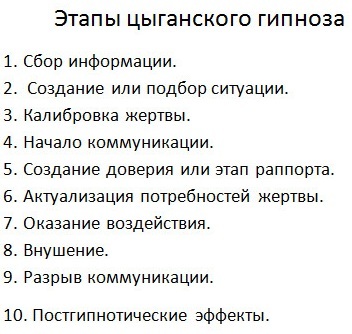
This perception overload technique has the following effects:
- speech;
- visual;
- kinesthetic.
Amateur hypnosis at home can be used to create mood, relaxation, getting rid of bad habits and working with self-esteem, however, it cannot be considered as panacea. Unprofessional influence on the psyche is strictly contraindicated in case of its deviations and the indicated health problems.
In this case, you should contact a specialist who can also help with enuresis, psychosomatic disorders, depression, stuttering and addiction. The human brain works according to certain laws, but hypnosis helps to use this for good purposes. To hypnotize, be aware that this is an interactive process.
When laying suggestions, you need to adapt them to the state of the hypnotized, for example, additionally repeating introductory phrases when he is not sufficiently relaxed, or without asking him to close his eyes if he is already closed them. An additional sense of trust and control can be created by talking about the visitor's precisely predictable movements and reactions.
Hidden hypnosis is no less interesting. For example, restaurant customers are more likely to order dishes from the beginning and end of the menu, as they attract more attention. French music can contribute to the choice of French wine. This broad direction helps to understand what determines the choices and actions of most people.
Author: Cash Diver
Hypnosis videos
About the benefits and harms of hypnosis:



